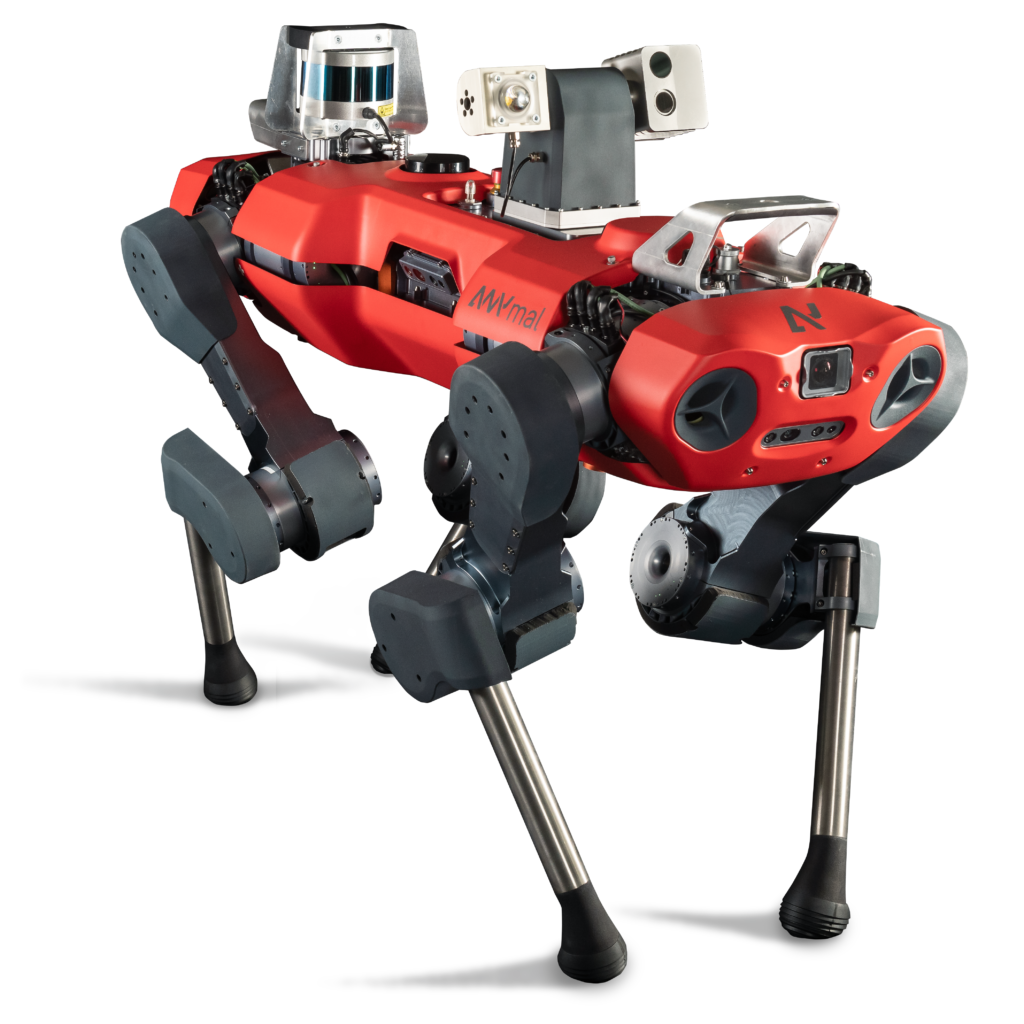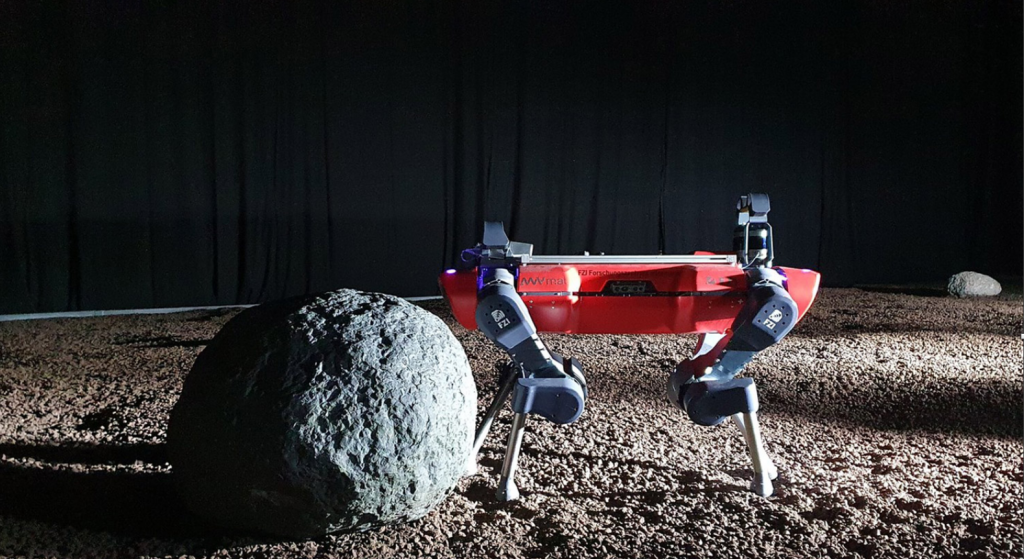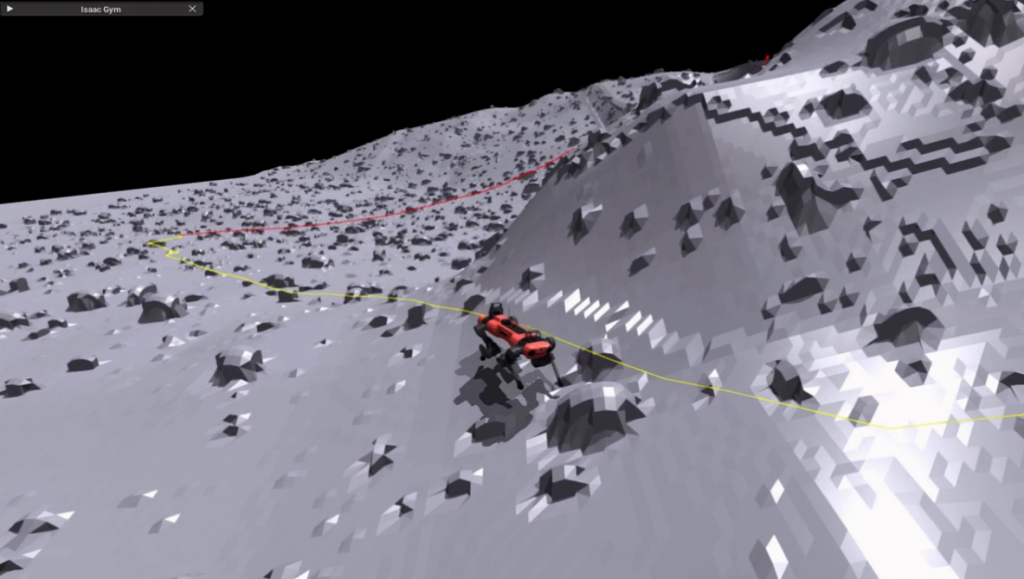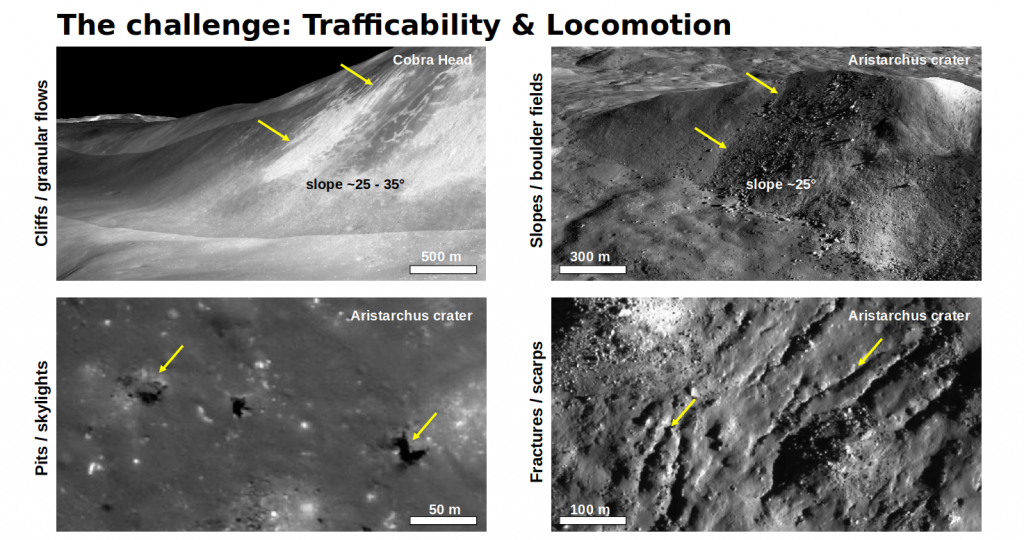Four-legged Jumping Robots LEAP to Explore the Moon
A four-legged robot trained through artificial intelligence has learned the same lesson as the Apollo astronauts – that jumping can be the best way to move around on the surface the Moon. An update on LEAP (Legged Exploration of the Aristarchus Plateau), a mission concept study funded by ESA to explore some of the most challenging lunar terrains, has been presented today at the Europlanet Science Congress (EPSC) 2022 in Granada by Patrick Bambach.
“LEAP’s target is the Aristarchus plateau, a region of the Moon that is particularly rich in geologic features but highly challenging to access,” said Patrick Bambach of the Max Planck Institute for Solar System Research in Germany. “With the robot, we can investigate key features to study the geologic history and evolution of the Moon, like the ejecta around craters, fresh impact sites, and collapsed lava tubes, where material may not have been altered by space weathering and other processes.”
The LEAP team is working towards the robot being integrated on ESA’s European Large Logistic Lander (EL3), which is scheduled to land on the Moon multiple times from the late 2020s to the early 2030s. LEAP is based on the legged robot, ANYmal, developed at ETH Zürich and its spin-off ANYbotics. It is currently adapted to the lunar environment by a consortium from ETH Zurich, the Max Planck Institute for Solar System Research, OHB, the University of Münster, and the Open University.
“Traditional rovers have enabled great discoveries on the Moon and Mars, but have limitations,” said Bambach. “Exploring terrain with loose soil, large boulders or slopes over 15 degrees are particularly challenging with wheels. For example, the Mars rover, Spirit, had its mission terminated when it got stuck in sand.”
ANYmal can move in different walking gaits, enabling it to cover large distances in a short amount of time, climb steep slopes, deploy scientific instruments, and even recover in the unlikely event of a fall. The robot can also use its legs to dig channels in the soil, flip over boulders or smaller rocks for further inspection, and pick up samples.
Initially, the robot has been trained using a Reinforcement Learning approach in a virtual environment to simulate the lunar terrain, gravity and dust properties. It has also been deployed in the field for an outdoor hike.
“Interestingly, ANYmal started to use a jumping-like mode of locomotion, just as the Apollo Astronauts did – realising that jumping can be more energy efficient than walking,” said Bambach.
The current design remains below 50 kg and includes 10 kg of scientific payload mass, notionally being capable of carrying multispectral sensors, ground penetrating radar, mass spectrometers, gravimeters, and other instrumentation.
“LEAP’s ability to collect selected samples and bring them to a lander or ascent vehicle offers additional exciting opportunities for sample a return missions in highly challenging environments on the Moon or Mars,” said Bambach.
Images




Animations
Video including simulations and a outdoor hike:
Science Contacts
Patrick Bambach
Max Planck Institute for Solar System Research
Germany
Media Contacts
EPSC2022 Press Office
+44 7756 034243
epsc-press@europlanet-society.org
Notes for Editors
About the Europlanet Science Congress (EPSC)
The Europlanet Science Congress (https://www.epsc2022.eu/) formerly the European Planetary Science Congress, is the annual meeting of the Europlanet Society. With a track record of 16 years, and regularly attracting around 1000 participants, EPSC is the largest planetary science meeting in Europe. It covers the entire range of planetary sciences with an extensive mix of talks, workshops and poster sessions, as well as providing a unique space for networking and exchanges of experiences.
Follow on Twitter via @europlanetmedia and using the hashtag #EPSC2022.
About Europlanet
Since 2005, Europlanet (www.europlanet-society.org) has provided Europe’s planetary science community with a platform to exchange ideas and personnel, share research tools, data and facilities, define key science goals for the future, and engage stakeholders, policy makers and European citizens with planetary science.
The Europlanet 2024 Research Infrastructure (RI) has received funding from the European Union’s Horizon 2020 research and innovation programme under grant agreement No 871149 to provide access to state-of-the-art research facilities and a mechanism to coordinate Europe’s planetary science community.
The Europlanet Society promotes the advancement of European planetary science and related fields for the benefit of the community and is open to individual and organisational members. The Europlanet Society is the parent organisation of the Europlanet Science Congress (EPSC).
About EANA
The European Astrobiology Network Association (http://www.eana-net.eu), joins together people interested in the origins of life and the search for extraterrestrial life in the Solar System and beyond. This interdisciplinary domain involves scientists from multiple disciplines such as chemistry, physics, biology, geology, astronomy, and human sciences.

